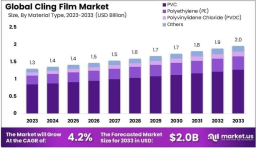

A whisper-thin film. Nearly invisible, yet indispensable. Cling film—sometimes called stretch wrap or plastic wrap—has become an unspoken sentinel in homes and industries alike. It hugs leftovers, protects produce, and guards goods through global supply chains. But beneath its glossy surface lies a story of evolving materials—each era defined by its own priorities, from preservation to sustainability.
What once worked flawlessly is now under scrutiny. As ecological alarms ring louder, the molecular architecture of packaging materials has become more than a scientific footnote—it’s a decisive factor in determining market success, brand reputation, and global environmental impact.
for more inform : https://market.us/report/cling-film-market/
Polyvinyl Chloride (PVC) didn’t just enter the stage; it dominated it. With its superior clinginess, pliability, and clarity, PVC-based cling film quickly became the go-to solution for food packaging. It stretched effortlessly. It adhered like magic. It was the unsung hero of convenience.
However, this plastic monarch had a darker side. PVC contains plasticizers—often phthalates—which can migrate into food, raising health concerns. More critically, the environmental footprint of PVC is colossal. Difficult to recycle, it releases toxic dioxins when incinerated. As governments and green-minded consumers pushed for alternatives, PVC’s reign began to wane.
Polyethylene (PE), particularly low-density polyethylene (LDPE), emerged as a safer and more recyclable contender. Free from plasticizers and relatively inert, it quickly gained favor across industries. It was flexible, less controversial, and more compliant with emerging recycling systems.
But perfection remained elusive. PE lacks the natural adhesion of PVC. It requires additives or heat sealing for the same effectiveness. And while technically recyclable, its thin-film nature clogs machinery and is often rejected by sorting systems. It’s an improvement—but not a solution.
Bioplastics are derived from renewable sources—corn starch, sugarcane, potato peels, and even algae. Materials like PLA (Polylactic Acid), PHA (Polyhydroxyalkanoates), and starch blends are designed to perform like traditional plastics, but with a biodegradable twist. They decompose under industrial composting, returning to the soil rather than polluting the sea.
The halo of sustainability shines bright on bioplastics, and consumers are listening. However, the compostability of these materials often depends on very specific conditions—rarely found in household compost bins. Moreover, bioplastics can’t be recycled with conventional plastics, creating confusion and contamination in recycling streams. A silver bullet they are not, but a promising dawn, perhaps.
In the performance arena, PVC still wins in cling and stretch. PE follows, and bioplastics—while improving—still struggle with achieving the same elasticity and moisture barrier required for longer shelf lives. Transparency, a crucial aesthetic and functional trait, is comparable in all but the most basic bioplastic wraps.
Price remains a critical hurdle. Bioplastics cost significantly more to produce than their petroleum-based counterparts. Scalability is improving, but fossil-based plastics still benefit from decades of infrastructure and economies of scale. Until bioplastics become circular in design and disposal, their market adoption remains cautious rather than explosive.
for more inform : https://market.us/report/cling-film-market/
Tomorrow’s cling film may not just wrap—it might think. Innovations in smart packaging, incorporating spoilage indicators and antimicrobial agents, are reshaping what films can do. Edible wraps made from seaweed, rice protein, or milk casein are emerging as biodegradable (and even digestible) solutions for specific applications.
The cling film material landscape will not evolve through innovation alone. It will require global cooperation—between policymakers, manufacturers, scientists, and consumers. Regulations must be clear, infrastructure supportive, and innovation relentless. Only then can the industry transcend its plastic past and step into a greener, smarter, stretchier future.
Conclusion
From the synthetic supremacy of PVC to the eco-challengers made of corn and cellulose, cling film is a material in metamorphosis. The story of its evolution isn’t just about plastic—it’s about people, the planet, and the persistent quest to wrap progress in something better.
| No comments yet. Be the first. |